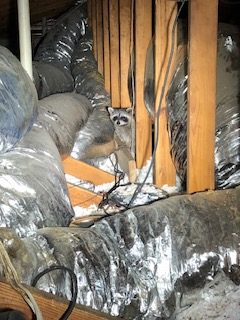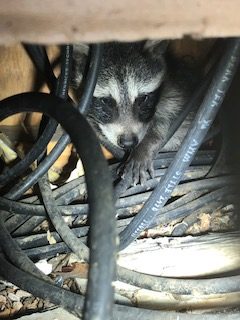A homeowner in Flower Mound heard loud thumping noises in the middle of the night. They investigated their attic and found dark, tubular droppings.
During our inspection, we found evidence of raccoon droppings and a raccoon den build in the insulation. If you look closely, you can spot the raccoon hiding between the rafters.

Why is a Raccoon in the Attic?
The natural denning site for raccoons is a hollow tree but can include rock crevices or abandoned animal burrows. Raccoons in Flower Mound are in attics looking for a safe place to to give birth. They will look for shelter near a source of water and readily available food.
Raccoons commonly take up residence in attics, as they are usually warm, quiet, and seldom visited by humans. Raccoons are some of the largest animals you’ll come across in a residential setting, so if a raccoon is in your attic, you might hear loud thumping noises that simply couldn’t be produced by a smaller animal.


Raccoons in the attic can cause significant damage. Last year, a raccoon in the attic fell through the ceiling.
When raccoons den in attics, they designate a specific areas as a latrine site. Their accumulated feces and urine quickly destroys insulation and saturates woodwork. Their feces spread raccoon roundworm, which is a serious health hazard for residents repairing raccoon damage to homes. In addition, fleas and ticks in raccoon fur can transfer to people or pets.
Raccoon in Attic Trapping
Raccoon trapping is the most effective way to get rid of a raccoon in the attic. Using scare tactics with raccoons will sometimes drive them away, but these methods don’t work when the animals become familiar with humans. Furthermore, excluding a mother raccoon from her nest may result in a litter of babies left inside a chimney or attic den.
After the raccoons have been trapped and removed, it is essential to repair the raccoon entry points. Despite the fairly large size of raccoons, the hole doesn’t have to be big. An adult raccoon can fit into a hole the size of a softball (3-4”).
Typical raccoon entry holes include soffits, loose shingles, roof and attic vents, or roof ridges.
For this homeowner, the raccoon infiltrated the attic through a loose soffit. We repaired the damage and installed sheet metal for added protection. The roof vents were vulnerable so we installed caps over them.


Brad Woods
Brad is the District Manager for Dallas-Fort Worth for Trutech Wildlife Service. He graduated from the University of Arkansas at Monticello with a Bachelor of Science in Forestry and a Masters of Forest Science. Brad has worked in wildlife removal for over seven years.


